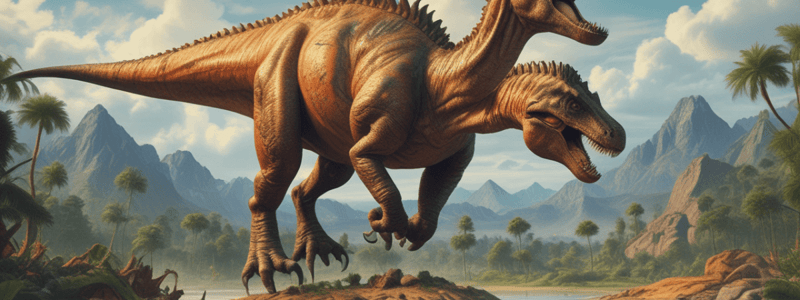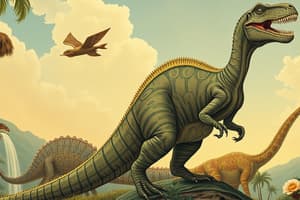Podcast
Questions and Answers
During which period did birds and mammals first appear, although in a primitive form?
During which period did birds and mammals first appear, although in a primitive form?
- Triassic Period
- Cretaceous Period
- Permian Period
- Jurassic Period (correct)
What event near the end of the Cretaceous period led to the extinction of non-avian dinosaurs?
What event near the end of the Cretaceous period led to the extinction of non-avian dinosaurs?
- Ice Age
- Evolutionary changes
- Large-scale volcanic eruptions in India (correct)
- Meteor impact
Why was the Dinosaur Age significant for the Earth's biosphere?
Why was the Dinosaur Age significant for the Earth's biosphere?
- It marked the rise of modern mammals
- It led to the dominance of birds over dinosaurs
- It shaped the current ecosystems on Earth (correct)
- It introduced large-scale volcanic activity
Which theory is concerned with motion in the absence of gravitational fields?
Which theory is concerned with motion in the absence of gravitational fields?
Which domain do the laws of classical physics accurately describe?
Which domain do the laws of classical physics accurately describe?
Who are some of the prominent physicists mentioned at the Solvay Conference of 1927?
Who are some of the prominent physicists mentioned at the Solvay Conference of 1927?
Which theory is concerned with the discrete nature of phenomena at the atomic and subatomic level?
Which theory is concerned with the discrete nature of phenomena at the atomic and subatomic level?
What type of motion is the general theory of relativity concerned with?
What type of motion is the general theory of relativity concerned with?
Which theory finds applications in many areas of modern physics according to the text?
Which theory finds applications in many areas of modern physics according to the text?
Who discovered the photoelectric effect and the theory of relativity?
Who discovered the photoelectric effect and the theory of relativity?
Which theory replaced classical mechanics for fast-moving bodies?
Which theory replaced classical mechanics for fast-moving bodies?
What problem did classical mechanics face with the speed of light?
What problem did classical mechanics face with the speed of light?
What aspect of black-body radiation provided a problem for classical physics?
What aspect of black-body radiation provided a problem for classical physics?
Who proposed that the excitation of material oscillators is possible only in discrete steps proportional to their frequency?
Who proposed that the excitation of material oscillators is possible only in discrete steps proportional to their frequency?
What did Max Planck's proposal about material oscillators lead to the development of?
What did Max Planck's proposal about material oscillators lead to the development of?
What did Einstein's framework of special relativity replace?
What did Einstein's framework of special relativity replace?
Which theory allowed an accurate description of systems with components approaching the speed of light?
Which theory allowed an accurate description of systems with components approaching the speed of light?
What did Planck, Schrödinger, and others introduce in physics?
What did Planck, Schrödinger, and others introduce in physics?
Which concept unifies quantum mechanics and special relativity?
Which concept unifies quantum mechanics and special relativity?
What type of spacetime does general relativity describe?
What type of spacetime does general relativity describe?
'Several candidate theories of quantum gravity' refers to attempts to unify what?
'Several candidate theories of quantum gravity' refers to attempts to unify what?
Flashcards are hidden until you start studying
Study Notes
Dinosaur Age
Introduction
The term "Dinosaur Age" refers to the period during which dinosaurs dominated the Earth's ecosystems. This era spanned approximately 163 million years, from the Late Triassic to the Late Cretaceous periods, covering the Middle Jurassic and Early Cretaceous epochs. The Mesozoic Era, often referred to as the "Age of Dinosaurs," comprises three periods: Triassic, Jurassic, and Cretaceous. Let's delve deeper into the timeline of the Dinosaur Age and explore what it entails.
Timeline
Triassic Period (252–166 million years ago)
The Triassic period marks the beginning of the era of reptile domination on Earth. It was characterized by the emergence of the first true dinosaurs, although the term "dinosaur" wasn't coined until several decades later. The climate during the Triassic was harsh and dry, and dinosaurs had to compete with crocodilian archosaurs, which posed a major challenge for their survival. Despite this competition, dinosaurs thrived and evolved into larger and more diverse forms throughout the Late Triassic.
Jurassic Period (166–145 million years ago)
The Jurassic period brought about significant changes in the dinosaur world. During this time, dinosaurs reached their peak in terms of size and variety. Some of the most famous dinosaurs, such as Stegosaurus, Brachiosaurus, and Diplodocus, emerged during the Jurassic period. Additionally, birds and mammals first appeared during the Jurassic, although they were still quite primitive compared to their modern counterparts. The relationship between dinosaurs and their descendants, birds, is less direct than commonly believed.
Cretaceous Period (145–66 million years ago)
The Cretaceous period marked the final chapter of the Dinosaur Age. During this period, dinosaurs continued to dominate the Earth's ecosystems, but they faced another threat – volcanism in the form of large-scale eruptions in the Deccan region of present-day India. These eruptions released immense quantities of ash and gases into the atmosphere, leading to drastic temperature fluctuations and potentially contributing to the end of the Dinosaur Age. The most catastrophic event in Earth's history – the Cretaceous-Tertiary (K-T) extinction – occurred near the end of the Cretaceous period, wiping out non-avian dinosaurs around 66 million years ago.
Importance of the Dinosaur Age
The Dinosaur Age was a crucial period in the Earth's biosphere because it laid the foundation for the world's current ecosystems. Although the transition from a world ruled by reptiles to one ruled by mammals was gradual, the overall impact of the Dinosaur Age on the planet's ecology cannot be underestimated. The plants, insects, and other invertebrates that evolved alongside the dinosaurs played a significant role in shaping the natural world as we know it today.
Studying That Suits You
Use AI to generate personalized quizzes and flashcards to suit your learning preferences.




